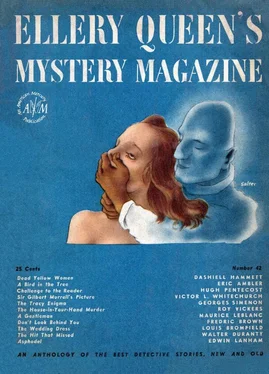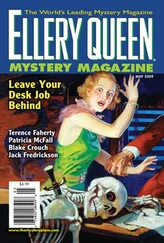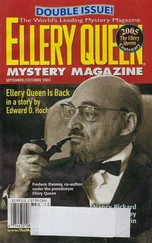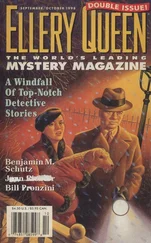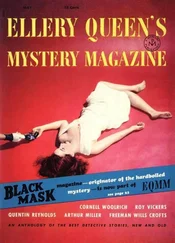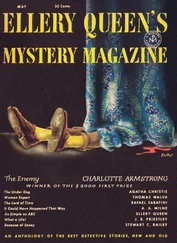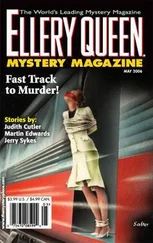Эрик Эмблер - Ellery Queen’s Mystery Magazine. Vol. 9, No. 42, May 1947
Здесь есть возможность читать онлайн «Эрик Эмблер - Ellery Queen’s Mystery Magazine. Vol. 9, No. 42, May 1947» весь текст электронной книги совершенно бесплатно (целиком полную версию без сокращений). В некоторых случаях можно слушать аудио, скачать через торрент в формате fb2 и присутствует краткое содержание. Город: New York, Год выпуска: 1947, Издательство: The American Mercury, Жанр: Классический детектив, Детектив, на английском языке. Описание произведения, (предисловие) а так же отзывы посетителей доступны на портале библиотеки ЛибКат.
- Название:Ellery Queen’s Mystery Magazine. Vol. 9, No. 42, May 1947
- Автор:
- Издательство:The American Mercury
- Жанр:
- Год:1947
- Город:New York
- ISBN:нет данных
- Рейтинг книги:3 / 5. Голосов: 1
-
Избранное:Добавить в избранное
- Отзывы:
-
Ваша оценка:
- 60
- 1
- 2
- 3
- 4
- 5
Ellery Queen’s Mystery Magazine. Vol. 9, No. 42, May 1947: краткое содержание, описание и аннотация
Предлагаем к чтению аннотацию, описание, краткое содержание или предисловие (зависит от того, что написал сам автор книги «Ellery Queen’s Mystery Magazine. Vol. 9, No. 42, May 1947»). Если вы не нашли необходимую информацию о книге — напишите в комментариях, мы постараемся отыскать её.
Ellery Queen’s Mystery Magazine. Vol. 9, No. 42, May 1947 — читать онлайн бесплатно полную книгу (весь текст) целиком
Ниже представлен текст книги, разбитый по страницам. Система сохранения места последней прочитанной страницы, позволяет с удобством читать онлайн бесплатно книгу «Ellery Queen’s Mystery Magazine. Vol. 9, No. 42, May 1947», без необходимости каждый раз заново искать на чём Вы остановились. Поставьте закладку, и сможете в любой момент перейти на страницу, на которой закончили чтение.
Интервал:
Закладка:
The murder of Albert Henshawk, headlined as the House-in-Your-Hand Mystery, became a test case for plainclothes constables who had put in for promotion. It is still used to emphasize that the most trivial remark of a murderer — such as a comment on a work of commercial art — may contain the raw material of a clue.
Henshawk, who specialized in financing the purchase of houses, had been running an advertisement showing, in an outstretched palm, a picturesque country cottage, with the slogan: A House in Your Hand is Worth Two in the Clouds. It is noteworthy that the picture in the advertisement was a photograph of a model. The whole model, including the outstretched hand, covered an area about equal to that of a pocket handkerchief. It was kept in Henshawk’s office under a glass dome, flanked by the bronze statuette with which Henshawk was battered to death. It is an ironical comment on this amiable egotist that the statuette was the work of Henshawk, and the subject — Henshawk himself.
A tubby, chubby little man in the early forties, he was naively proud of himself and his not inconsiderable talent as an artist. “Neat bit of work, that model, eh! Supplied the idea myself,” he would say, if you were a business acquaintance. Your attention would be directed to the seventeenth-century thatched cottage, to the oaks on one side of it, to the sloping meadow in which a cow drank at a sluggish brook, to a somewhat startling confusion of farm stock in the foreground.
“And, mind you, it isn’t a studio fake, except for those pigs and things. Made from a drawing. A little effort of my own.” You were urged to inspect a charcoal drawing — complete with farm stock but minus the outstretched palm — hung in a somewhat elaborate frame. “Of course, I’m only an amateur, but you can see it’s drawn from life.”
The last statement was confirmed, after the murder, by a number of experts, consulted independently. Each said, in his own words, that if the model had been a work of fancy it would have exhibited certain essential differences. Architects, also consulted independently, passed the house as structurally and historically correct; surveyors agreed that the layout of the land contained no absurdity.
The murder took place on February 16th, 1938, at about six forty-five, in Henshawk’s office in Gorlay House, Westminster. After lunching at the Redmoon Restaurant, Henshawk had spent the afternoon at his club, discussing business with an official of a big investment trust, for which he was, in effect, an agent.
At a few minutes past six, when his staff had left, with the exception of his secretary, he entered his room by the private door, which opened directly on the corridor. In the wall on your right as you entered by this door was another door, now ajar, to the staff room, in which Miss Birdridge was waiting.
She heard his key, then his voice talking to a companion. Of the latter she had only an oblique view. But she was able to state that he was between forty and fifty, of medium height, regular features, and with an iron-grey mustache.
“I must have a word with my secretary — shan’t be a minute,” Henshawk was saying. “Suppose you look about until I get back. I think you’ll be pleased.” He went into the staff room, leaving the communicating door open.
“Miss Birdridge, I simply must get that report off tonight. So will you go and have a meal right away, and be back here at seven sharp.” Henshawk had a booming voice: the other man must have overheard him. “Oh, and you might ’phone Mrs. Henshawk that I shan’t be home till about ten and I’ll eat in Town.”
There was nothing unusual in this. Miss Birdridge was a middle-aged woman with no home ties, who appreciated a restaurant dinner at the firm’s expense and the extra payment for late work. Henshawk lingered in the doorway while she reported an item of minor importance, but she noticed that his attention had shifted to the other room.
“Ah! It caught your eye at once, old man. Neat bit of work, eh! Made from that drawing of mine on the wall there.”
Then the other man’s voice: “But, my dear fellow, that damned cow spoils the whole thing! And why is it perched on a giant’s hand? Makes it look like a cartoon.”
“You’re not far off. I’ve been using it for an advertisement display. I felt sure you wouldn’t mind. After all—”
At that point the communicating door was closed. Miss Birdridge was sure that it was exactly at that point, and sure that she had reported the exact words used by each man.
She went out to dinner, returning as Big Ben was striking seven. In the meantime the communicating door had been used and was again ajar. A couple of minutes later, having equipped herself for work on the report, she went into the inner office, to find Henshawk sprawling face downwards, over his chair patently murdered. She observed no more than this before rushing back into the outer office and calling the police.
By midnight, Detective Inspector Karslake had a clear outline. For about forty minutes, during which he had smoked four of Henshawk’s cigarettes, the murderer had sat in the client’s chair, with his back to both doors.
At about six-forty, Henshawk’s wife had knocked on the private door. Henshawk had opened the door but had stepped into the corridor to speak to her. He told her, she said, that he was engaged with a client, so could not take her home. He himself expected to be home late.
Over her husband’s shoulder Mrs. Henshawk had seen a man sitting in the client’s chair with his back towards her. She did not take particular notice of him, because, she said, being a client he was of no interest to her. She was somewhat hurt because her husband had apparently forgotten that he had asked her to call for him at the office.
After getting rid of his wife, Henshawk had probably sat down again in his chair. But a few minutes later he had got up and turned his back, whereupon the other had struck him on the back of the head with the statuette, causing almost instant death.
At the cupboard-toilette the murderer had washed bloodstains from his hands. He had not removed bloodstains from the soap well. He had left the statuette immersed in the basin.
Although his time was running perilously short, he had lingered in order to remove a drawing from its frame on the wall. As this drawing was the original from which the House-In-Your-Hand model was made, the incident gave emphasis to the remark, overheard by Miss Birdridge, seeming to connect the deceased with the cottage depicted in the model.
The murderer left by the outer office, within two minutes of seven o’clock, carrying the drawing loosely wrapped in tissue paper. In the hall he asked the porter to call him a taxi. He was getting into it when Miss Birdridge returned, though she noticed no more than that a man was getting into a taxi, carrying something flat and loosely wrapped in tissue paper. He told the driver to take him to the Westminster Station of the Underground. Nothing further was known of his movements.
“The porter is no good, sir,” said young Rawlings. “All he can do is a ‘middle aged, middle height, middling well-dressed gentleman with a mustache’ — which of course will be shaved off by now.”
“Never mind his mustache — he has practically left us his address, hasn’t he!” snorted Karslake. He had recently had several big successes and was becoming a trifle didactic.
“Yes, sir — that cottage!” said Rawlings, who had not yet learned how to handle seniors.
“I guessed that myself,” snapped Karslake. “Where is that cottage? What’s it called?”
Rawlings slunk away and woke Miss Birdridge by calling her on the telephone.
But Miss Birdridge did not know, had always thought the cottage was an imaginary one until she had overheard the murderer’s reference to it. Next he rang Mrs. Henshawk, who was equally unhelpful. Her husband was a prolific amateur artist, but she knew nothing about art and he never talked to her about his hobby.
Читать дальшеИнтервал:
Закладка:
Похожие книги на «Ellery Queen’s Mystery Magazine. Vol. 9, No. 42, May 1947»
Представляем Вашему вниманию похожие книги на «Ellery Queen’s Mystery Magazine. Vol. 9, No. 42, May 1947» списком для выбора. Мы отобрали схожую по названию и смыслу литературу в надежде предоставить читателям больше вариантов отыскать новые, интересные, ещё непрочитанные произведения.
Обсуждение, отзывы о книге «Ellery Queen’s Mystery Magazine. Vol. 9, No. 42, May 1947» и просто собственные мнения читателей. Оставьте ваши комментарии, напишите, что Вы думаете о произведении, его смысле или главных героях. Укажите что конкретно понравилось, а что нет, и почему Вы так считаете.
